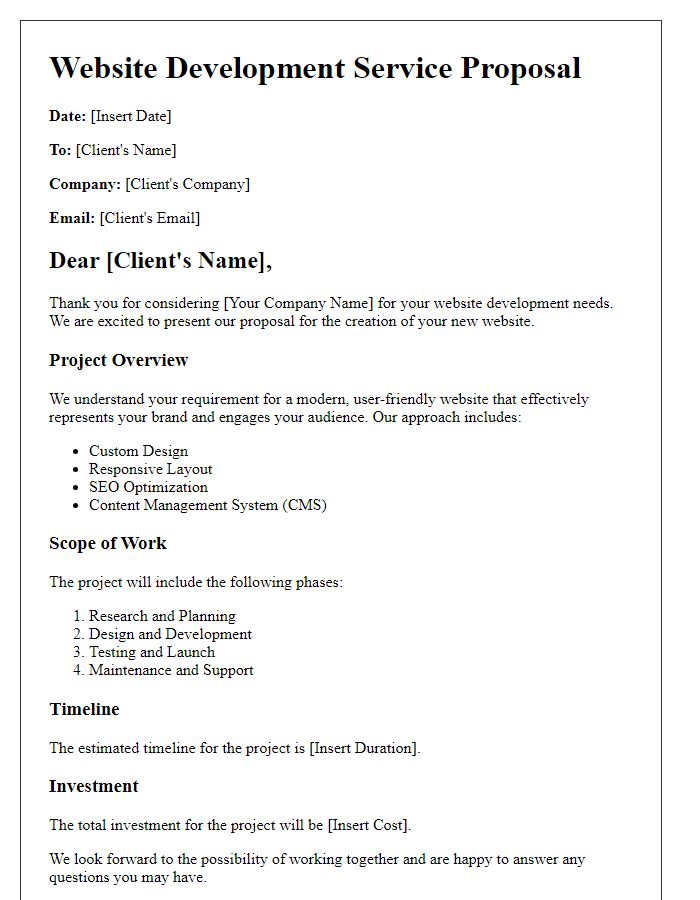Are you ready to take your digital presence to the next level? Crafting a solid web development contract is essential to ensure both you and your developer are on the same page. This agreement not only outlines project details but also safeguards your interests and fosters a successful partnership. Dive into our article to explore a versatile letter template that will guide you through creating the perfect web development contract!

Project Scope and Deliverables
A comprehensive web development contract should include a clear outline of the project scope and deliverables. Key components within this section encompass the specific functionalities of the website, visual design aspects, and overall user experience (UX) requirements. The project scope may consist of creating a responsive design, which ensures compatibility across various devices, such as smartphones, tablets, and desktops. Key deliverables include milestones like the initial wireframe design, client review phases, and final launch date. Additionally, integration with third-party services, such as payment gateways or APIs, needs specification. Timeline estimates should accompany each deliverable, detailing progress checks and testing phases to ensure functionality and aesthetics meet agreed expectations.
Payment Terms and Schedule
Payment terms in web development contracts often include a detailed schedule outlining milestones and associated payments. Standard practices involve an initial deposit (typically 30-50% of the total project cost) due upon contract signing to secure the project start date. Following this, subsequent payments align with project milestones; for example, the second payment may be due upon completion of the design phase, while the final balance is often required before the website launch. Clear stipulations regarding late fees (e.g., 1.5% monthly fees on overdue amounts) are critical. Optional clauses may include provisions for additional work requests, clearly defining billing rates for extra hours to prevent misunderstandings. Adherence to payment timelines ensures smooth project progression and fosters effective collaboration between client and developer.
Intellectual Property Rights
Intellectual Property Rights (IPR) play a crucial role in web development projects, protecting the rights of developers and clients. In web development contracts, the ownership of code, design elements, and content must be clearly defined to prevent disputes. Typically, developers use a Creative Commons license or proprietary rights to safeguard unique elements, while clients may seek full ownership of the final product. Specific clauses addressing the transfer of rights, usage permissions, and restrictions on reutilization can ensure that both parties understand their legal standings. Notable cases in IP disputes, such as Oracle versus Google (2010), serve as reminders of the importance of establishing clear IPR terms. A well-drafted contract will include provisions for trademark registrations and copyright filings to further protect unique identifiers like logos or branding materials associated with the web project. Clients should also be mindful of terminology such as "work for hire," which clarifies that the developer relinquishes rights once compensation is received.
Confidentiality Agreement
A confidentiality agreement is a crucial document in web development projects that protects sensitive information exchanged between parties, such as proprietary code, client business strategies, or user data. In a typical agreement, terms specify the duration of confidentiality, which often spans several years beyond project completion, usually three to five years. Key elements include definitions of confidential information, obligations of both parties to maintain secrecy, and stipulations for legal compliance. Consequences for breaches of confidentiality may include financial penalties, legal recourse, or termination of the contractual relationship. Geographic considerations, like jurisdiction in case of disputes, often reference specific legal entities, such as New York State or California. The agreement serves as a safeguard ensuring that both developers and clients can collaborate effectively without risking unauthorized disclosure of vital information.
Termination Clauses
Termination clauses in a web development contract outline the conditions under which either party can terminate the agreement. Key elements include notice periods, typically 30 days, required for either party to indicate intent to terminate. Circumstances for termination may include breach of contract, non-payment, or failure to meet project milestones. Additionally, termination rights may extend to situations involving insolvency or material change in business structure. Upon termination, clients must settle all outstanding invoices for completed work. Data ownership and intellectual property rights must also be clearly defined, ensuring protection of proprietary materials post-termination. This legal framework safeguards both developers and clients, maintaining professionalism and clarity in business relationships.













Comments